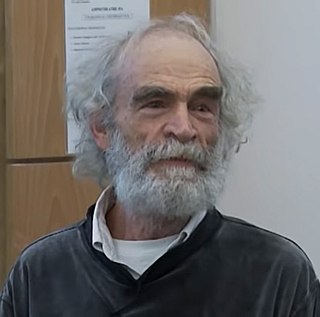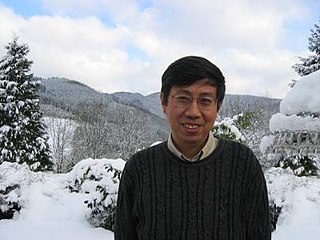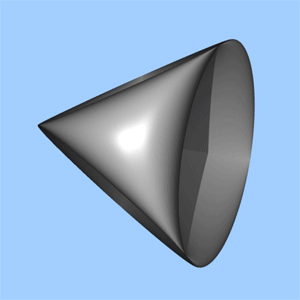Related Research Articles

Michael Hartley Freedman is an American mathematician at Microsoft Station Q, a research group at the University of California, Santa Barbara. In 1986, he was awarded a Fields Medal for his work on the 4-dimensional generalized Poincaré conjecture. Freedman and Robion Kirby showed that an exotic ℝ4 manifold exists.

Mikhael Leonidovich Gromov is a Russian-French mathematician known for his work in geometry, analysis and group theory. He is a permanent member of Institut des Hautes Études Scientifiques in France and a professor of mathematics at New York University.

In mathematics, systolic geometry is the study of systolic invariants of manifolds and polyhedra, as initially conceived by Charles Loewner and developed by Mikhail Gromov, Michael Freedman, Peter Sarnak, Mikhail Katz, Larry Guth, and others, in its arithmetical, ergodic, and topological manifestations. See also a slower-paced Introduction to systolic geometry.

Tian Gang is a Chinese mathematician. He is a professor of mathematics at Peking University and Higgins Professor Emeritus at Princeton University. He is known for contributions to the mathematical fields of Kähler geometry, Gromov-Witten theory, and geometric analysis.
The Oswald Veblen Prize in Geometry is an award granted by the American Mathematical Society for notable research in geometry or topology. It was funded in 1961 in memory of Oswald Veblen and first issued in 1964. The Veblen Prize is now worth US$5000, and is awarded every three years.
In mathematics, in particular in differential geometry, the minimal volume is a number that describes one aspect of a smooth manifold's topology. This diffeomorphism invariant was introduced by Mikhael Gromov.

In differential geometry, Loewner's torus inequality is an inequality due to Charles Loewner. It relates the systole and the area of an arbitrary Riemannian metric on the 2-torus.

In differential geometry, Pu's inequality, proved by Pao Ming Pu, relates the area of an arbitrary Riemannian surface homeomorphic to the real projective plane with the lengths of the closed curves contained in it.
In Riemannian geometry, Gromov's optimal stable 2-systolic inequality is the inequality
In the mathematical field of Riemannian geometry, M. Gromov's systolic inequality bounds the length of the shortest non-contractible loop on a Riemannian manifold in terms of the volume of the manifold. Gromov's systolic inequality was proved in 1983; it can be viewed as a generalisation, albeit non-optimal, of Loewner's torus inequality and Pu's inequality for the real projective plane.
In differential geometry, Mikhail Gromov's filling area conjecture asserts that the hemisphere has minimum area among the orientable surfaces that fill a closed curve of given length without introducing shortcuts between its points.

Marcel Berger was a French mathematician, doyen of French differential geometry, and a former director of the Institut des Hautes Études Scientifiques (IHÉS), France. Formerly residing in Le Castera in Lasseube, Berger was instrumental in Mikhail Gromov's accepting positions both at the University of Paris and at the IHÉS.
In Riemannian geometry, the filling radius of a Riemannian manifold X is a metric invariant of X. It was originally introduced in 1983 by Mikhail Gromov, who used it to prove his systolic inequality for essential manifolds, vastly generalizing Loewner's torus inequality and Pu's inequality for the real projective plane, and creating systolic geometry in its modern form.

Systolic geometry is a branch of differential geometry, a field within mathematics, studying problems such as the relationship between the area inside a closed curve C, and the length or perimeter of C. Since the area A may be small while the length l is large, when C looks elongated, the relationship can only take the form of an inequality. What is more, such an inequality would be an upper bound for A: there is no interesting lower bound just in terms of the length.
In geometry, an essential manifold is a special type of closed manifold. The notion was first introduced explicitly by Mikhail Gromov.
In mathematics, systolic inequalities for curves on surfaces were first studied by Charles Loewner in 1949. Given a closed surface, its systole, denoted sys, is defined to be the least length of a loop that cannot be contracted to a point on the surface. The systolic area of a metric is defined to be the ratio area/sys2. The systolic ratio SR is the reciprocal quantity sys2/area. See also Introduction to systolic geometry.
The volume entropy is an asymptotic invariant of a compact Riemannian manifold that measures the exponential growth rate of the volume of metric balls in its universal cover. This concept is closely related with other notions of entropy found in dynamical systems and plays an important role in differential geometry and geometric group theory. If the manifold is nonpositively curved then its volume entropy coincides with the topological entropy of the geodesic flow. It is of considerable interest in differential geometry to find the Riemannian metric on a given smooth manifold which minimizes the volume entropy, with locally symmetric spaces forming a basic class of examples.
Mikhail "Mischa" Gershevich Katz is an Israeli mathematician, a professor of mathematics at Bar-Ilan University. His main interests are differential geometry, geometric topology and mathematics education; he is the author of the book Systolic Geometry and Topology, which is mainly about systolic geometry. The Katz–Sabourau inequality is named after him and Stéphane Sabourau.
The systole (or systolic category) is a numerical invariant of a closed manifold M, introduced by Mikhail Katz and Yuli Rudyak in 2006, by analogy with the Lusternik–Schnirelmann category. The invariant is defined in terms of the systoles of M and its covers, as the largest number of systoles in a product yielding a curvature-free lower bound for the total volume of M. The invariant is intimately related to the Lusternik-Schnirelmann category. Thus, in dimensions 2 and 3, the two invariants coincide. In dimension 4, the systolic category is known to be a lower bound for the Lusternik–Schnirelmann category.
In mathematics, the Besicovitch inequality is a geometric inequality relating volume of a set and distances between certain subsets of its boundary. The inequality was first formulated by Abram Besicovitch.
References
- Berger, Marcel (1993), "Systoles et applications selon Gromov", Séminaire Bourbaki (in French), 1992/93. Astérisque 216, Exp. No. 771, 5, 279–310.
- Croke, Christopher B.; Katz, Mikhail (2003), "Universal volume bounds in Riemannian manifolds", Surveys in differential geometry, VIII (Boston, MA, 2002), Somerville, MA: Int. Press, pp. 109–137.
- Freedman, Michael H. (1999), "Z2-systolic-freedom", Proceedings of the Kirbyfest (Berkeley, CA, 1998), Geom. Topol. Monogr., vol. 2, Coventry: Geom. Topol. Publ., pp. 113–123.
- Freedman, Michael H.; Meyer, David A.; Luo, Feng (2002), "Z2-systolic freedom and quantum codes", Mathematics of quantum computation, Comput. Math. Ser., Boca Raton, FL: Chapman & Hall/CRC, pp. 287–320.
- Freedman, Michael H.; Meyer, David A. (2001), Projective plane and planar quantum codesjournal=Found. Comput. Math., vol. 1, pp. 325–332.
- Gromov, Mikhail (1996), "Systoles and intersystolic inequalities", Actes de la Table Ronde de Géométrie Différentielle (Luminy, 1992), Sémin. Congr., vol. 1, Paris: Soc. Math. France, pp. 291–362.
- Katz, Mikhail (1995), "Counterexamples to isosystolic inequalities", Geom. Dedicata, 57 (2): 195–206, doi:10.1007/bf01264937, S2CID 11211702 .